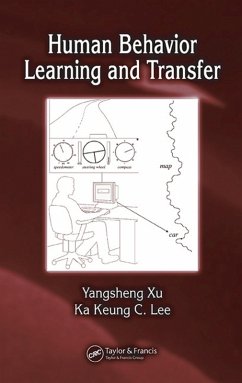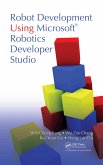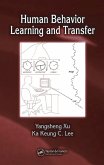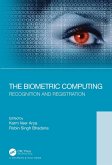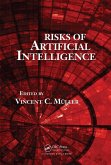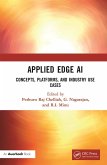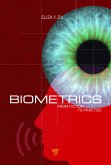52,95 €
52,95 €
inkl. MwSt.
Sofort per Download lieferbar

26 °P sammeln
52,95 €
Als Download kaufen

52,95 €
inkl. MwSt.
Sofort per Download lieferbar

26 °P sammeln
Jetzt verschenken
Alle Infos zum eBook verschenken
52,95 €
inkl. MwSt.
Sofort per Download lieferbar
Alle Infos zum eBook verschenken

26 °P sammeln
- Format: PDF
- Merkliste
- Auf die Merkliste
- Bewerten Bewerten
- Teilen
- Produkt teilen
- Produkterinnerung
- Produkterinnerung

Bitte loggen Sie sich zunächst in Ihr Kundenkonto ein oder registrieren Sie sich bei
bücher.de, um das eBook-Abo tolino select nutzen zu können.
Hier können Sie sich einloggen
Hier können Sie sich einloggen
Sie sind bereits eingeloggt. Klicken Sie auf 2. tolino select Abo, um fortzufahren.

Bitte loggen Sie sich zunächst in Ihr Kundenkonto ein oder registrieren Sie sich bei bücher.de, um das eBook-Abo tolino select nutzen zu können.
Bridging the gap between human-computer engineering and control engineering, Human Behavior Learning and Transfer delineates how to abstract human action and reaction skills into computational models. The authors include methods for modeling a variety of human action and reaction behaviors and explore processes for evaluating, optimizing, and trans
- Geräte: PC
- mit Kopierschutz
- eBook Hilfe
- Größe: 27.4MB
Andere Kunden interessierten sich auch für
![Robot Development Using Microsoft Robotics Developer Studio (eBook, PDF) Robot Development Using Microsoft Robotics Developer Studio (eBook, PDF)]() Shih-Chung KangRobot Development Using Microsoft Robotics Developer Studio (eBook, PDF)72,95 €
Shih-Chung KangRobot Development Using Microsoft Robotics Developer Studio (eBook, PDF)72,95 €![Human Behavior Learning and Transfer (eBook, ePUB) Human Behavior Learning and Transfer (eBook, ePUB)]() Yangsheng XuHuman Behavior Learning and Transfer (eBook, ePUB)52,95 €
Yangsheng XuHuman Behavior Learning and Transfer (eBook, ePUB)52,95 €![The Biometric Computing (eBook, PDF) The Biometric Computing (eBook, PDF)]() The Biometric Computing (eBook, PDF)52,95 €
The Biometric Computing (eBook, PDF)52,95 €![Artificial Intelligence (eBook, PDF) Artificial Intelligence (eBook, PDF)]() Richard E. NeapolitanArtificial Intelligence (eBook, PDF)41,95 €
Richard E. NeapolitanArtificial Intelligence (eBook, PDF)41,95 €![Risks of Artificial Intelligence (eBook, PDF) Risks of Artificial Intelligence (eBook, PDF)]() Risks of Artificial Intelligence (eBook, PDF)44,95 €
Risks of Artificial Intelligence (eBook, PDF)44,95 €![Applied Edge AI (eBook, PDF) Applied Edge AI (eBook, PDF)]() Applied Edge AI (eBook, PDF)43,95 €
Applied Edge AI (eBook, PDF)43,95 €![Biometrics (eBook, PDF) Biometrics (eBook, PDF)]() Biometrics (eBook, PDF)113,95 €
Biometrics (eBook, PDF)113,95 €-
-
-
Bridging the gap between human-computer engineering and control engineering, Human Behavior Learning and Transfer delineates how to abstract human action and reaction skills into computational models. The authors include methods for modeling a variety of human action and reaction behaviors and explore processes for evaluating, optimizing, and trans
Dieser Download kann aus rechtlichen Gründen nur mit Rechnungsadresse in A, B, BG, CY, CZ, D, DK, EW, E, FIN, F, GR, HR, H, IRL, I, LT, L, LR, M, NL, PL, P, R, S, SLO, SK ausgeliefert werden.
Produktdetails
- Produktdetails
- Verlag: Taylor & Francis eBooks
- Seitenzahl: 352
- Erscheinungstermin: 6. September 2005
- Englisch
- ISBN-13: 9781420036978
- Artikelnr.: 53373418
- Verlag: Taylor & Francis eBooks
- Seitenzahl: 352
- Erscheinungstermin: 6. September 2005
- Englisch
- ISBN-13: 9781420036978
- Artikelnr.: 53373418
- Herstellerkennzeichnung Die Herstellerinformationen sind derzeit nicht verfügbar.
Yangsheng Xu received his Ph.D. from University of Pennsylvania in the area of robotics in 1989. He has been with the Department of Automation and Computer-Aided Engineering at The Chinese University of Hong Kong (CUHK) since 1997, and served as department chairman from 1997 to 2004. Prof. Xu is currently a chair professor in the department and he was a faculty member at the School of Computer Science, Carnegie Mellon University (CMU) from 1989 to 1999. Prof. Xu's research interests have been in robotics and human interface, and their applications in service, aerospace, and industry. At first he worked on designing and controling robots for space operations. He also made contributions in human control strategy modeling and applications in real-time control. His more recent efforts have been concentrated on wearable interface, intelligent surveillance, and future space systems. He has been a principal investigator in more than 30 projects funded by both governments and industries. Based on his research work, he has fortunately published over 70 papers in journals, 130 papers in international conferences, and several book contributions and books. He has been serving or served on advisory boards or panels in various government agencies and industries in the United States, Japan, Korea, Hong Kong, and mainland China. He is a fellow of IEEE, HKIE, and IEAS. Ka Keung Lee received his bachelor of information technology and bachelor of engineering (hons.) degrees from the Australian National University (ANU) in 1995 and 1997, respectively. From ANU, he received a full-fee international undergraduate scholarship for the years 1992-1996. He received the master of philosophy and doctor of philosophy degrees from the Department of Automation and Computer-Aided Engineering at The Chinese University of Hong Kong in 2000 and 2004, respectively. Dr. Lee worked in the School of Computer Science of the Australian Defence Force Academy (ADFA) in 1995; was a visiting scholar at the Division of Information Technology of the Commonwealth Scientific and Research Organisation (CSIRO), Australia in 1996; and served as a software engineer in the computer harddisk industry in Hong Kong in 1997-1998. His current research interests include human action modeling, human sensation modeling, intelligent surveillance, and wearable robotics. Currently, Dr. Lee is a postdoctoral fellow in the Department of Automation and Computer-Aided Engineering at The Chinese University of Hong Kong.
Introduction. Introduction to Human Reaction Skill Modeling. Leaning of
Human Control Strategy: Continuous and Discontinuous. Validation of Human
Control Strategy Models. Evaluation of Human Control Strategy. Performance
Optimization of Human Control Strategy. Transfer of Human Control Strategy.
Transferring Human Navigational Skills to Smart Wheelchair. Introduction to
Human Action Skill Modeling. Global Parametric Methods for Dimension
Reduction. Local Methods for Dimension Reduction. A Spline Smoother in
Phase Space for Trajectory Fitting. Analysis of Human Walking Trajectories
for Surveillance. Modeling of Facial and Full-Body Actions. Conclusions.
Human Control Strategy: Continuous and Discontinuous. Validation of Human
Control Strategy Models. Evaluation of Human Control Strategy. Performance
Optimization of Human Control Strategy. Transfer of Human Control Strategy.
Transferring Human Navigational Skills to Smart Wheelchair. Introduction to
Human Action Skill Modeling. Global Parametric Methods for Dimension
Reduction. Local Methods for Dimension Reduction. A Spline Smoother in
Phase Space for Trajectory Fitting. Analysis of Human Walking Trajectories
for Surveillance. Modeling of Facial and Full-Body Actions. Conclusions.
Introduction. Introduction to Human Reaction Skill Modeling. Leaning of
Human Control Strategy: Continuous and Discontinuous. Validation of Human
Control Strategy Models. Evaluation of Human Control Strategy. Performance
Optimization of Human Control Strategy. Transfer of Human Control Strategy.
Transferring Human Navigational Skills to Smart Wheelchair. Introduction to
Human Action Skill Modeling. Global Parametric Methods for Dimension
Reduction. Local Methods for Dimension Reduction. A Spline Smoother in
Phase Space for Trajectory Fitting. Analysis of Human Walking Trajectories
for Surveillance. Modeling of Facial and Full-Body Actions. Conclusions.
Human Control Strategy: Continuous and Discontinuous. Validation of Human
Control Strategy Models. Evaluation of Human Control Strategy. Performance
Optimization of Human Control Strategy. Transfer of Human Control Strategy.
Transferring Human Navigational Skills to Smart Wheelchair. Introduction to
Human Action Skill Modeling. Global Parametric Methods for Dimension
Reduction. Local Methods for Dimension Reduction. A Spline Smoother in
Phase Space for Trajectory Fitting. Analysis of Human Walking Trajectories
for Surveillance. Modeling of Facial and Full-Body Actions. Conclusions.
